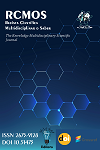Application of machine learning techniques in hospital management optimization
Application of machine learning techniques in hospital management optimization
DOI:
https://doi.org/10.51473/rcmos.v1i1.2025.1015Keywords:
Machine Learning, K-Means, Hospital Management, Clustering, Data AnalysisAbstract
This study aims to apply the K-Means clustering algorithm to identify disease patterns and support decision-making at Catapa Hospital. In this context, the integration of emerging technologies, particularly Artificial Intelligence and Machine Learning becomes essential for improving clinical data analysis and optimizing health resource administration.
The methodology involved the collection and processing of 4,050 clinical records, covering variables such as date of attendance, neighborhood, gender, age, age group, type of disease, and neighborhood classification. After data preprocessing, the K-Means algorithm enabled the formation of five clusters composed of patients with similar characteristics.
The analysis indicated that the Catapa neighborhood (classified as peri-urban) accounts for approximately 58% of malaria and fever cases. The youth age group represents 38.4% of the records, followed by children (32.3%), adolescents (14.9%), adults (11.8%), and the elderly (2.6%), with a slight predominance of the male gender (50.1%). Catapa alone accounts for 37% of recorded cases; Mbemba Ngango for 15%; Kindenuku for 10%; Dunga for 5%; Papelão for 3%; and the remaining 34 neighborhoods for 30%. June had the highest incidence, with about 36% of all occurrences. Regarding neighborhood types, peri-urban areas reported 73.6% of cases, urban areas 24.6%, and rural areas 1.9%.
Additionally, an interactive dashboard was developed using the Dash library, allowing dynamic visualization of data and results, providing hospital managers with a practical tool for evidence-based analysis and decision-making. The findings demonstrate that K-Means clustering is effective in identifying patterns and supporting hospital management.
Downloads
References
Filho, C. R. (2020). TÉCNICAS DE INTELIGÊNCIA ARTIFICIAL APLICADAS AOS PROCESSOS DE GESTÃO HOSPITALAR . 11.
Marius Sumanas, A. P. (21 de Maio de 2022). Deep Q-Learning in Robotics: Improvement of Accuracy. p. 16.
Maronna, R. A. (2017). Norman Matloff (2017): statistical regression and classification: from linear models to machine learning. classification: from linear models to machine learning(National University of La Plata).
Mechelli, A. (2019). Methods and Applications ML. Machine Learning.
Mitchell, T. (1997). Machine Learning. 1(Machine Learning is the study of computer algorithms that improve automatically through experience.), 9.
Mohri, M. (2018). Foundations of Machine Learning. second edition, 505.
Neves, S. A. (2018). Técnicas de Aprendizado de Máquina . TFC, I(Classificação da Qualidade de Pavimentos Asfálticos), 49.
Pedro, N. (2024). Utilização de técnicas de aprendizagem automática em contexto académico para tipificação do risco de abandono escolar . Thesis_MSC_Final_Rev, 91.
RUSSELL, S., & NORVIG. (2016). Inteligência Artificia. Pearson.
Samuel, A. M. (2011). Proposta metodológica para resolução das equações redutíveis ao segundo grau lR. Caso das equações biquadráticas e irracionais. Isced, Uíge, Agola.
SHAPIRO, S. C. (1992). Encyclopedia of artificial intelligence.
Sutton, R. S. (2018). Reinforcement Learning. An Introduction, Second edition(Complete Draft), 38.
Zhang, W. (2024). International Journal of Mental Health Promotion. p. 26. DOI: https://doi.org/10.32604/ijmhp.2023.045819
Downloads
Additional Files
Published
Issue
Section
Categories
License
Copyright (c) 2025 Jorge Faitoma, Nicolau Pedro, Nkanga Pedro (Autor)

This work is licensed under a Creative Commons Attribution 4.0 International License.












